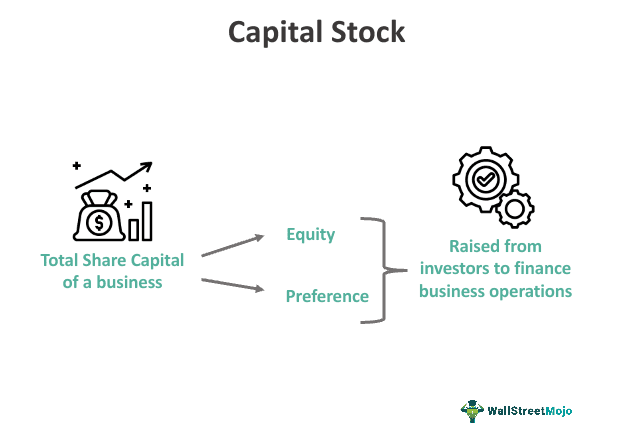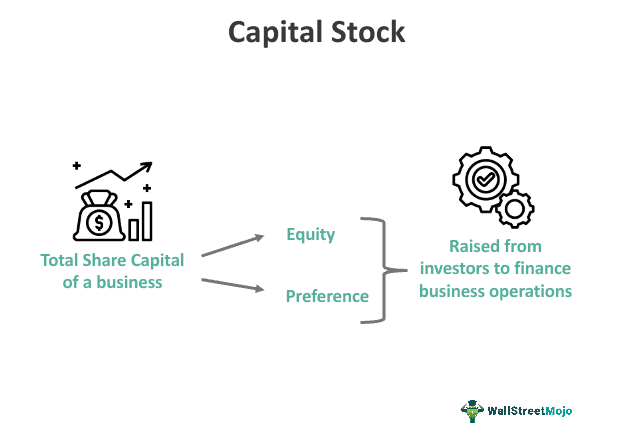Table Of Contents
What Is Capital Stock?
The capital stock is the total share capital (including equity capital and preference capital) that a company has issued. It is a means of raising funds for the company to meet its various business goals. The same can be found in the balance sheet in the "shareholder's equity column."

This refers to the amount that the entity can raise from investors. It is a very important component of the financial structure used as a source of funding for its investments, expansion, and growth. As per the corporate charter, the company is authorized to issue this amount to shareholders. It denotes the maximum amount of outstanding share capital of the entity.
Capital Stock Explained
The capital stock of a company typically refers to all categories of stock that the entity can issue to the investors and use the funds raised for investment, development and growth. It includes preferred and common stocks and is issued upto the level authorized by the company charter. The shares are then subscribed by investors and the amount gets listed in the company’s balance sheet.
It is a very good method for companies to raise funds without incurring any amount of debt. The investors who subscribe to the share capital expect the return in either dividends or appreciation of stock prices. This is possible only if the company can utilize its capital stock in a productive manner, leading to useful and productive investment of those funds.
If the management can identify profitable opportunities for using the capital raised through authorized capital stock and efficiently run its operations, the business will run profitably and generate enough return to pay back its shareholders in the form of dividends or price appreciation.
Even though this method ensures that the company can keep its debt burden under control and reduce the amount of money flowing out in the form of interest against loans, the fact that this process dilutes management control is also true.
However, the firm capital stock represents the ownership of shareholders in the capital of the company. It is the residual interest in the assets after deducting the value of its liabilities. This capital can increase or decrease based on certain corporate actions, like issue of new shares, buyback of stocks, etc, which influence the share capital and thus, the overall financial structure, affecting shareholder’s ownership.
Types
It can be divided into the following types:
- Authorized = The authorized capital stock represents the maximum share capital a company can issue, as mentioned in its legal charter. It can be altered by changing its legal charter after following prescribed procedures.
- Issued = It means the total amount of share capital presently issued by the company out of its authorized capital stock. It is worthy to note that issued capital cannot exceed the authorized capital stock.
- Unissued = It reflects the part of authorized capital stock that the company has not issued yet.
- Outstanding = It means those issued shares which are still held by the stockholders (i.e., those shares which are not bought back by the company)
- Treasury Shares =Treasury Shares means those issued shares bought back by the company.
- Common shares – They are those that are also known as equity stocks. The shareholders of the same have the right to vote in important management decisions and have an ownership stake in the capital of the company. However, their right to dividend and receipt of claim in case of bankruptcy or liquidation comes after all other claims have been settled.
- Preferred shares – These shareholders have the right to claims and dividends of the company before common shareholders. However, they do not have any or limited voting rights in case of important decision-making.
Formula
The formula for calculating firm capital stock in the balance sheet is as follows:
Capital Stock = Number of Shares Issued * Par Value Per Share

It is calculated by multiplying the number of shares issued with the par value per share. The par value is actually the nominal or the face value of each stock, which represents the minimum amount at which each stock can be sold.
Examples
Let us understand the method of concept of capital stock economics and calculation by way of examples.
Example #1
A company issued 5,000 shares at $6 per share, having a par value of $5 each.
Solution
Calculation of Capital Stock

- = 5,000 * 5
- = $25,000
Example #2
A company has issued equity as well as preference shares as follows-
- 6,000 equity shares were issued at a par value of $10 each.
- 7,000 preference shares were issued at a par value of $8 each;
Solution
Calculation of Capital Stock

- = 6,000*10 + 7,000*8
- = $1,16,000
The above examples clearly show how to identify and calculate the stock from the financial statements of the company. This data can be found in the balance sheet under the shareholder equity section.
Studying and understanding this section and overall capital stock economics is essential for investors, creditors, and other business stakeholders because it gives them an idea about the capital structure and leverage position. A high amount of capital stock proves that the debt is very low, which is good due to less obligation to repay the debt funds, but on the other hand, more stocks issued leads to dilution of capital from management to the hands of shareholders.
Advantages
The following are the advantages of capital stock on balance sheet which are listed below:
- The company's dependence on external debt is reduced.
- The company is free to use the funds for as long as it needs, while if it opts to take outside loans, it will need to repay them after a certain fixed period.
- It shows the investors' trust in the company and thus increases its credibility.
- Unlike in the case of debt financing, the investors need not be paid a fixed income every year. A company can pay dividends according to its financial condition.
- There is freedom for the company to use the funds as per its goals without any restrictions.
Disadvantages
The following are the disadvantages which are listed below:
- The dividend that the company pays is not a tax-deductible expense.
- The control of the company is diluted when it is issued.
- The company is subjected to various laws and regulations when it issues it and thus is more complicated than taking a loan, for instance.
- The approval of stockholders is required to make major decisions in the company. It may be serious trouble in case of disagreement with the stockholders.
Capital Stock Vs Common Stock
Even though both refer to the two types of stocks issued by the company to raise funds from the market, there are some differences between the two. Let us try to identify them.
- The capital stock on balance sheet is a broader term that includes all kinds of stocks that are issued to raise capital to finance the business operations. It will include both common and preferred shares. But the latter refers to only common shares.
- The capital stocks may or may not have voting rights because it depends on the type of stocks. The common stockholders have voting rights in case of management decision making and receive dividends after dividends to all other classes of shares have been paid.
- The latter bear the greatest risk in case of lack of profitability or liquidation and bankruptcy because they are the last in line to receive claims. But since the former includes both, the preferred shareholders’ risk is comparatively lesser than common shareholders since they get a preference over common shareholders.
Thus, the above are some important differences between the two.


